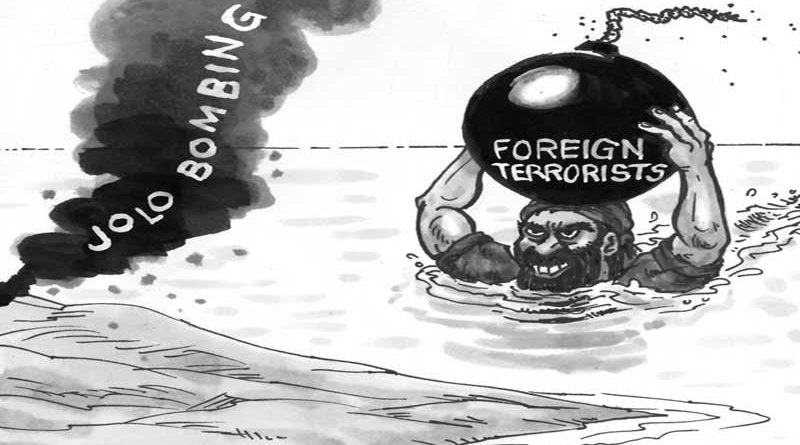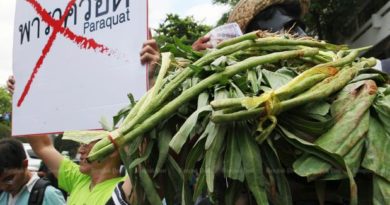OP ED EDITORIAL & CARTOONS: … Suicide bombers
He’s the commander-in-chief and therefore privy to classified information. So people believe President Duterte when he announces that two foreign suicide bombers were likely responsible for the explosions that killed at least 21 people and wounded about 100 others during the morning mass last Sunday at the cathedral in Jolo, Sulu.
A woman blew herself up inside the church while her male companion, said to be her husband, was responsible for the blast in a military outpost just outside the Our Lady of Mount Carmel cathedral, the President said. Both bombers were reportedly Yemenis.
The President also reportedly declared war on the terrorist Islamic State, giving credence to the group’s claim of responsibility for the attack. Security officials had earlier dismissed the IS claim, pointing instead to an Abu Sayyaf cell, called Ajang-Ajang, as the likely culprit. Yesterday, the Armed Forces conducted airstrikes on Abu Sayyaf lairs in Sulu, heralding the start of an offensive against the extremist group.
Counterterrorism officials said the information on the Yemeni couple, which apparently came from a Singapore-based security analyst, still had to be validated. For now, however, the statement of the commander-in-chief is not going to be ignored.
This would take the extremist threat to a new and potentially more dangerous level. Suicide bombers are among the most lethal weapons in the terrorist arsenal. Filipino Islamists are not known to be suicidal, preferring instead to commit homicide and murder.
Defense officials are reportedly monitoring around 40 foreigners believed to be terrorists in Basilan, Sulu and parts of SOCCSKSARGEN. While validating intel, security officials cannot afford to discount the possible involvement of foreigners in the attack on the Jolo cathedral. It wouldn’t be the first time: an Indonesian bomb-maker of the terrorist group Jemaah Islamiyah was convicted in connection with the deadly bomb attacks on a Light Rail Transit coach and several other targets in Metro Manila on Dec. 30, 2000.
The idea of foreign suicide bombers operating in the Philippines may sound wild. With 21 people dead and about 100 others wounded, however, no angle can be considered too farfetched to pursue. If the terrorist threat has been carried to a new level, security officials cannot afford to be unprepared.
ADS by Cloud 9:
.
– SPACE RESERVE FOR YOUR ADVERTISEMENT –
.
ASEANEWS – EDITORIAL – CARTOONS:
<>

<>
The Manila Times – ….MUSLIM INSURGENCY IN MINDANAO

<>


<>
Pilipino STAR Ngayon – Curfew sa minors hindi naipatutupad

SINGAPORE’S The Straits Times

.
.
The sweeping charges levelled against Chinese telecoms firm Huawei and its chief financial officer Meng Wanzhou by United States officials this week could lead to a prolonged and bruising legal battle that can only heighten tensions between China and the US. There are also potentially serious international repercussions as Huawei operates globally and is the leading supplier of 5G networks in several countries. US officials have levelled 23 charges against Huawei, some of which also apply to Meng. Among them: misrepresenting the nature of Huawei’s business with Iran to the US government and banks, in violation of US sanctions, stealing technology and obstructing justice.While Meng, who is the daughter of Huawei’s founder, fights possible extradition from Canada to the US, where she could face criminal proceedings, US officials claim that this is a judicial affair, unconnected with the ongoing US-China trade dispute. But there are reasons to doubt this claim, reinforced by US President Donald Trump’s statement last month that he would be willing to intervene in Meng’s extradition if it would help him reach a trade deal with China.TO READ THE FULL ARTICLE:
https://www.straitstimes.com/opinion/st-editorial/huawei-case-has-broad-implications
<>
THAILAND’S Bangkok Post – OPINION
A holistic haze solution
After much hesitation, the Bangkok Metropolitan Administration (BMA) has finally declared Bangkok and its vicinity as pollution control zones and intensified its efforts to reduce the levels of PM2.5 dust…
read more: https://www.bangkokpost.com/opinion/opinion/1620874/a-holistic-haze-solution
.In a meeting with several agencies on Jan 29, Natural Resources and Environment Minister Surasak Karnjanarat said he aims to put long-term measures in place to deal with the dust. The minister and the government have to realise his goal cannot be achieved without a proactive, holistic approach.
.
ADS by Cloud 9:
.
– SPACE RESERVE FOR YOUR ADVERTISEMENT –
.
.
 All photographs, news, editorials, opinions, information, data, others have been taken from the Internet ..aseanews.net | [email protected] |.For comments, Email to :D’Equalizer | [email protected] | Contributo
All photographs, news, editorials, opinions, information, data, others have been taken from the Internet ..aseanews.net | [email protected] |.For comments, Email to :D’Equalizer | [email protected] | Contributo










